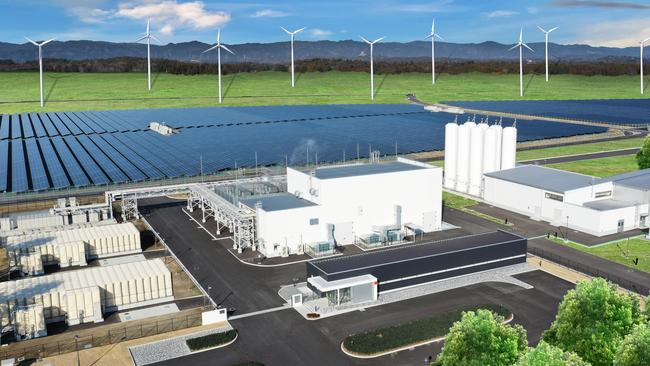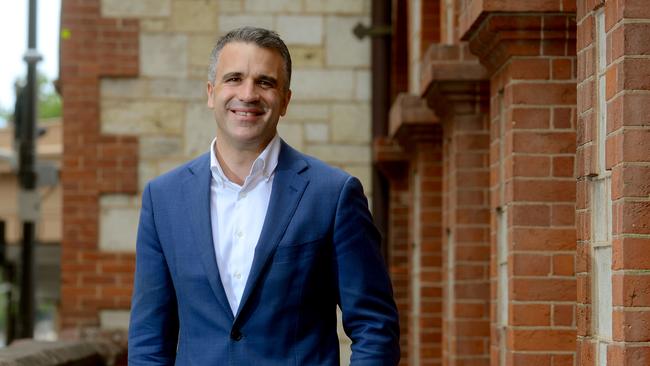Labor leader Peter Malinauskas unveils his big election pitch: A $593m hydrogen power plan to generate thousands of jobs
Peter Malinauskas has responded to Steven Marshall’s riverbank arena with his own signature policy – a massive investment in renewable energy.

SA News
Don't miss out on the headlines from SA News. Followed categories will be added to My News.
A hydrogen-fired power station designed to cut electricity bills and create thousands of jobs would be built, owned and operated by a Labor state government.
In his first major election policy release, Opposition Leader Peter Malinauskas has detailed a $593m Hydrogen Jobs Plan, aimed at harnessing South Australia’s wind and solar energy to generate clean power.
The hydrogen policy predicts up to 300 jobs would be created during the plant’s construction, along with at least another 10,000 through kickstarting projects from a $20bn pipeline of proposed renewable energy investments in SA. At least a further 900 jobs would be generated by developing a hydrogen export industry.
Labor estimates the 200MW electricity station would be able to power between 60,000 and 90,000 homes. The proposed site for the power station and plant is still being assessed but Mr Malinauskas is vowing it will be finished by the end of 2025.
The Labor hydrogen policy comes just four days after Premier Steven Marshall – exactly a year out from the March 2022 election – unveiled plans for a $700m arena in Adelaide’s Riverbank precinct.
The State Government on Tuesday morning revealed a study of green hydrogen export to Rotterdam, in the Netherlands, which is Europe’s largest port and is developing a hydrogen hub to supply the region with renewable energy.
Mr Malinauskas said the COVID-19 pandemic had emphasised the need to build domestic manufacturing industries and seize opportunities to grow jobs and prosperity.
“It’s about delivering sovereign capability around manufacturing, underpinned by clean, affordable power that we can produce, because of our unique set of circumstances,” he told The Advertiser.
“We’re going to stop talking about these things and put them into action.”
Labor’s three-point Hydrogen Plan involves:
■ A 200MW hydrogen power station costing $342m, designed to cut power prices for business and minimise the threat of household solar systems being switched off during times of excess grid production.
■ Using excess renewable energy to turn water into hydrogen with a 250MWe, $220m electrolyser, triggering demand for the $20 billion worth of renewable energy projects in the pipeline for SA.
■ A $31m hydrogen storage facility holding 3600 tonnes – sufficient to fuel the power station for two months.
Independent analysis by Frontier Economics forecasts the hydrogen plant would reduce wholesale electricity by 8 per cent, which it says would “benefit customers through lower retail electricity prices”.
If elected next March, Labor would establish a government-owned enterprise, to be called Hydrogen Power SA, to own and operate the power station.
With a similar structure to SA Water, it would operate with an independent board and have the mandate of rejuvenating manufacturing by using hydrogen-generated electricity to grow jobs and industries. Hydrogen Power SA also would be charged with developing a hydrogen export strategy.
Mr Malinauskas said government needed to take leadership to “take the first big step to underpin such an investment and transformation”.
He said Labor had proven leadership on renewables, citing Elon Musk’s Tesla Big Battery kickstarted in 2017 by former premier Jay Weatherill and subsequently expanded under the Liberal government to 150MW.

“We have a proven track record with government leadership in renewables, whether it be the big battery or otherwise, this is the next big step. We can’t sit around and wait,” Mr Malinauskas said.
“We need to act now if we’re going to grab that opportunity. Otherwise, we’re going to watch other states take it off our hands, we’re going to see other parts of the world take it off of our hands – that will only lead to a further offshoring of our jobs, particularly in industry, particularly around manufacturing.”
The Frontier Economics analysis says the “significant” project would be a unique combination of hydrogen-powered turbine, storage and commercial-scale electrolyser – the latter larger than any operating now.
Frontier, which also advised Labor’s 2017 energy plan, says the project would need water supply but the annual amount required would be less than one day’s production from the Adelaide desalination plant, at Lonsdale.
Former Australian chief scientist Dr Alan Finkel has strongly backed the development of a hydrogen industry, saying this can create jobs and lucrative export opportunities.
Dr Finkel’s new road map, outlined in The Advertiser on Monday, declares solar and wind energy must become Australia’s main energy sources to get the nation to net zero carbon emissions by 2050.
Energy Minister Dan van Holst Pellekaan said the state’s Hydrogen Action Plan released in 2019 had a vision of becoming a world-class renewable hydrogen supplier, which could help lead to SA producing about 500 per cent of current grid demand in renewable energy by 2050.
“Europe will remain a net importer of energy. However, it will gradually shift from grey to green,” he said.
“The Port of Rotterdam wants to facilitate this shift by stimulating the development of new supply chains of hydrogen.”
About $15m has been earmarked to support green hydrogen production projects led by AGIG at Tonsley, H2U at Cultana, and Neoen in the state’s Mid North.





